The abbey of Saint Antimo is reached by following a straight path, which stretches slowly between the slopes of verdant hills, adorned with centuries-old olive and cypress trees, and expanses of green vineyards. These are the noble Brunello crops that spread out in the Montalcino sun, as in Castelnuovo dell’Abate. But the visitor’s path also needs to be right, covered at least with good intentions. Saint Antimo is not reached by accident. Along the path, the Abbey stands isolated and elevated in the middle of the valley of the Starcia stream; there is nothing around it but the land to rule and sky to look up to.
People transit here only by choice and the place was a pilgrimage route since the Middle Ages, when it was a focal point of the Via Francigena. Many wayfarers intending to reach Jerusalem stopped at Sant’Antimo in order to find material and spiritual refreshment. The journey presupposed abandonment and uncertainty, leaving behind the securities of life and challenging the future. This was the way of enlightenment, the inner path to achieve the fullness of existence, which only Christ Lumen gentium could provide. So today those who decide to go to the Abbey of Saint Antimo can still walk the “way of light,” as the monks wisely called the guided tour of the building. And what better guide than the light that reveals and covers everything with splendor??
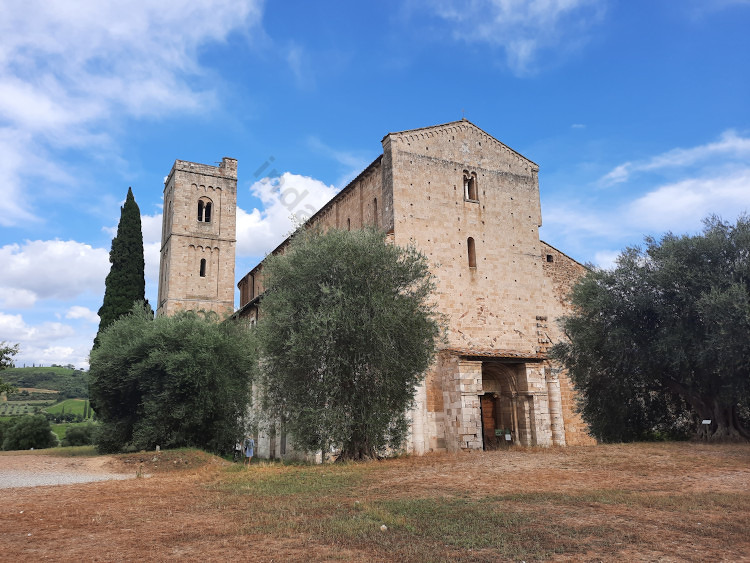
The history of the abbey of Saint Antimo
Tradition says that the abbey of Saint Antimo was founded by Emperor Charlemagne in the late 8th century1. The story relates that the ruler, on his way back from Rome with his retinue along the Via Francigena, faced a sudden plague epidemic. Hence, he decided to stop in the Starcia Valley. When the pestilence ceased by grace received, Charlemagne wished to found the abbey of Saint Antimo as a dissolution of the vow. This is most likely a legend, which nevertheless has some elements of truth. Historiography suggests that an early coenoby at Castelnuovo dell’Abate could exist as early as 770, when the Longobards had entrusted the Pistoian abbot Tao with the management of the territory’s property and the construction of a Benedictine abbey2.
“Tao once abbot and Tanimundo abbot of the said monastery built it and there with God’s favor aggregated a group of monks”.
Diploma from King Berengar II and King Adalbert to Abbot Betto dated March 12, 951 or 952, State Archives of Siena, author’s translation
In 814 the monastery received a donation from Louis the Pious, the fourth son of Charlemagne3. A privilege sent on December 29 of that year from Aachen, and addressed to Abbot Apollinaris, conferred the territory of Montalcino on the abbey of Saint Antimo. It is assumed that the abbey immediately benefited from the extensive economic privileges dictated by imperial rank – the abbot himself was awarded the title of Count of the Holy Roman Empire – growing in prestige and power. Subsequent concessions received from John XV in 992 and Emperor Henry III in 1051 confirmed the central role that the abbey of Saint Antimo played in the political and religious framework of the time4. By the turn of year 1000 the abbey territories extended as far as Lucca and Orbetello5, and there were about one hundred and eighty possessions including castles, mills, funds, hospitalia, churches and monasteries.
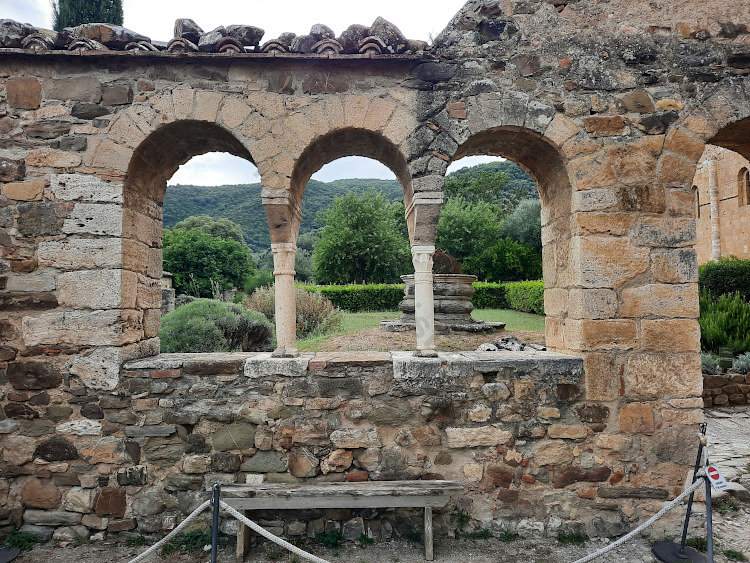
Who was Sant’Antimo?
In addition to the difficulties concerning a possible historical reconstruction of the abbey’s early centuries, due to the fact that much of the documentation was burned in a fire, there is uncertainty about the identity of the titular saint, Antimo. Again tradition states that Charlemagne, at the time of the foundation, gave the monks his relics, together with those of Sebastian, received from Pope Hadrian I. In the Martyrologium Hieronymianum Antimo is recorded under the date of May 11, with the words “Via Salaria miliario vigisimo secundo natale sancti Antimi6“
Indeed, in Rome, along the Via Salaria, lived this saint, who was martyred during Diocletian’s persecutions7. Thus, there is no certain evidence as to why the Roman Antimo finds such important veneration in Tuscany. Instead, it is far more likely that the Abbey’s original dedication was to another homonymous saint, whose memory was lost over time with the passage of centuries and the historical vicissitudes of the diocese. In the 6th-century Passio Donati a deacon from Arezzo is mentioned, martyred in 362 under Emperor Julian the Apostate, and also called Antimo8.
In the hagiographic story, the bishop Saint Donatus and his deacons were celebrating a holy mass in Arezzo when some pagans burst into the church, breaking the glass communion chalice. Antimo, not caring that the cup was shattered, continued to serve the wine without any drop falling to the ground. At such a sight the pagans were converted, but persecution began: St. Donatus was martyred there, while the deacon escaped. It is believed, however, that Antimo was finally caught up and killed in the Starcia Valley. It is possible that a small early Christian oratory was erected on the burial site, which explains why Tao was ordered to build a monastery precisely in Castelnuovo dell’Abate.
The present abbey of Saint Antimo
The current abbey of Saint Antimo is the result of a great reconstruction in the Romanesque styles carried out in the 12th century. An inscription, placed near the floor of the presbytery and the pillar to its left, attests that in 1117 the monastery received a very rich donation from Count Bernardo degli Ardengheschi9. In the following year Abbot Guidone began the work of renovation, which found inspiration in the Benedictine monastery of Cluny. Valued artists from beyond the Alps certainly came to Saint Antimo building site: among the capitals surmounting the columns there is one of exceptional workmanship depicting Daniel in the lions’ den, the work of an anonymous French sculptor known as the Master of Cabestany.
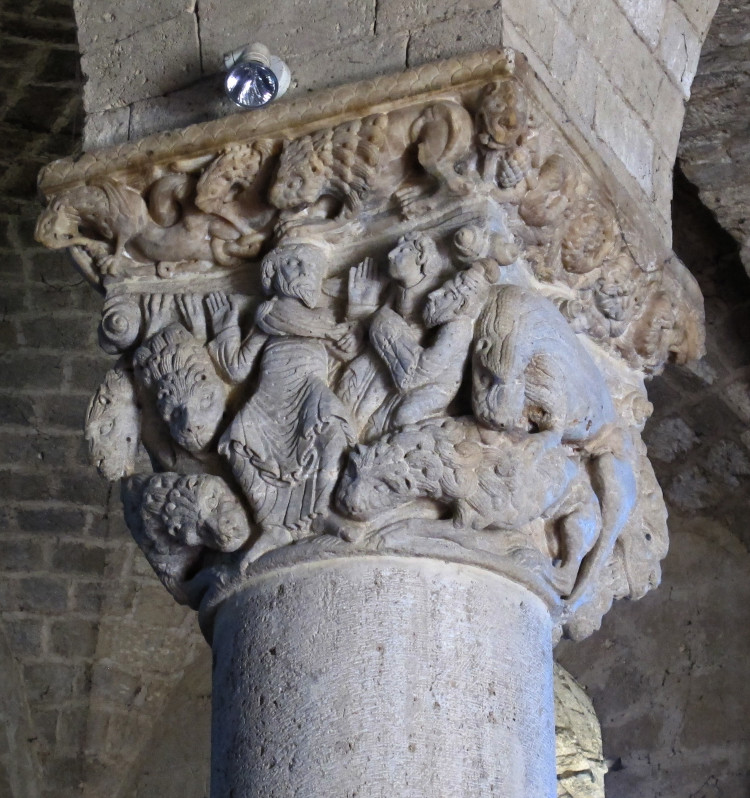
However, the expansion of the abbey complex, which included the addition of the cloister, had to require large sums of money. Hence, by the second half of the 12th century the religious community of Saint Antimo faced great economic difficulties. The final decline occurred in conjunction with contrasts against Siena, which began to take possession of the abbey territories to compete in power with its enemy Florence. In 1291 the Abbey of Saint Antimo was entrusted by Pope Nicholas IV to the order of the Guglielmites11 and was finally suppressed in 1462 at the behest of Pius II, who assigned its property to the nascent diocese of Pienza and Montalcino12. After various vicissitudes, the Abbey experienced a long period of neglect and decay, and only with the restorations of the late 19th century could return to its ancient splendor.
On the way to light
Today’s Abbey has a nave and two aisles, marked by cruciform pillars and columns with capitals on round arches. The nave, with its wooden truss ceiling, is distinguished by its accentuated verticalism, enhanced by the essential and mystical light that, from the monofore of the apse and the sides, penetrates its spaces without hesitation. The light narrates, reveals the presence of the women’s galleries and the clerestory, sculpts the cross vaults of the aisles. It is the absolute and unchallenged protagonist, creeping brightly into the ambulatory that runs around the chancel.
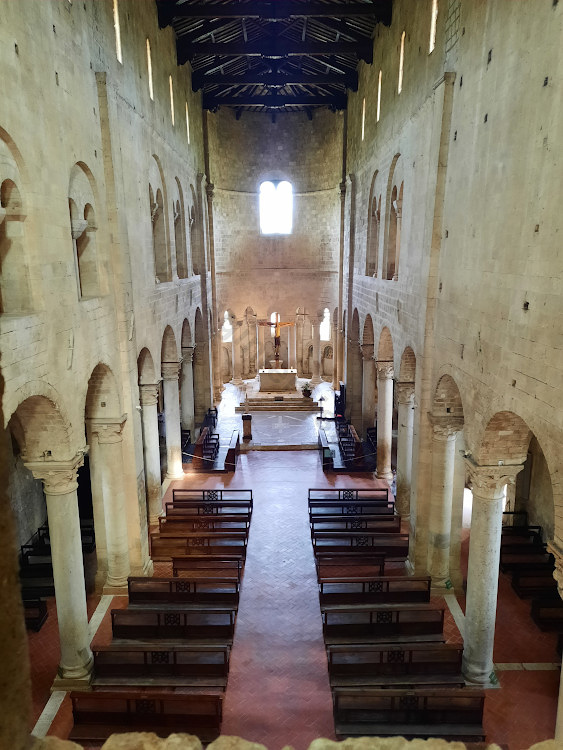
An extraordinary peculiarity of the building is the material used for its construction: the squared blocks are made of travertine with alabaster veins, locally sourced. The stone, thus, seems to enclose within itself the essence of light itself, since the alabaster allows itself to penetrate and lets the material shine. In the ambulatory, when in the morning the sun’s rays come through the monofora of the apsidoles, a vibrant play of colors fills the spaces with a mystical atmosphere.
The ambulatory
The ambulatory is Saint Antimo’s real architectural innovation, an ingenious of French models, as seen in the church of Saint’Etienne at Vignory in Champagne (11th century). The abbey church was a pilgrimage destination along the Via Francigena: a building of worship and transit, therefore, so it was necessary to allow pilgrims to pray over the relics of the martyrs without interfering with liturgical services, which took place in the main altar. The ambulatory, with its three radial chapels arranged along the apsidal semicircle, was meant to serve precisely that purpose.
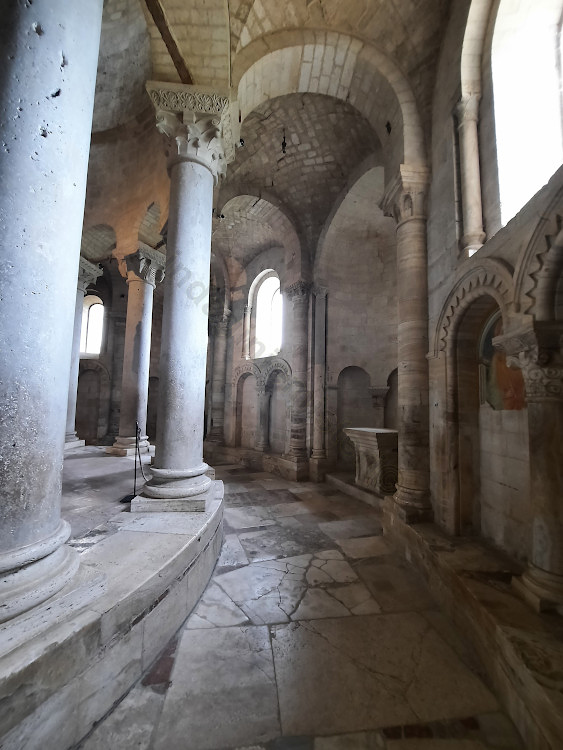
The Carolingian Chapel, the oldest structure in the abbey of Saint Antimo’s
There is no transept in the abbey of Saint Antimo, instead a square bell tower rises on its northern flank and on the other, almost matching, the oldest core of the monastic complex, a small apsidal church called the Carolingian Chapel. It is a small square hall, on two levels, now used as a sacristy. Inside are fine frescoes painted by Giovanni D’Asciano in the 14th century, depicting scenes from the life of Saint Benedict. Below the chapel is then the crypt, divided into a nave and two aisles by four columns with pulvinos made of porphyry.
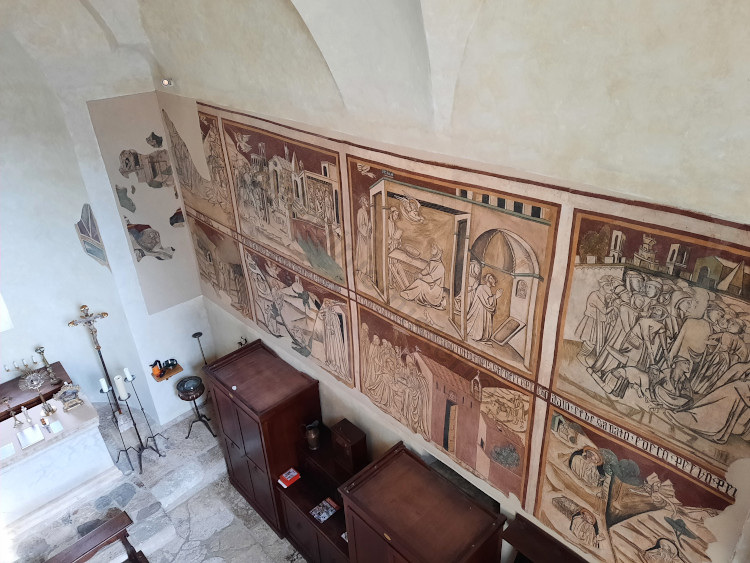
The cloister, chapter house and monastic pharmacy
From the Carolingian Chapel the visitor can reach the women’s galleries, through an internal staircase, or go outside, passing through the monastic pharmacy. This leads to the cloister, or at least what remains of it: scanty remnants, and a three-mullioned wall of the chapter house. The cloister is overlooked by the the church’s beautifully crafted side portal, possibly a remnant of the earlier construction phase.
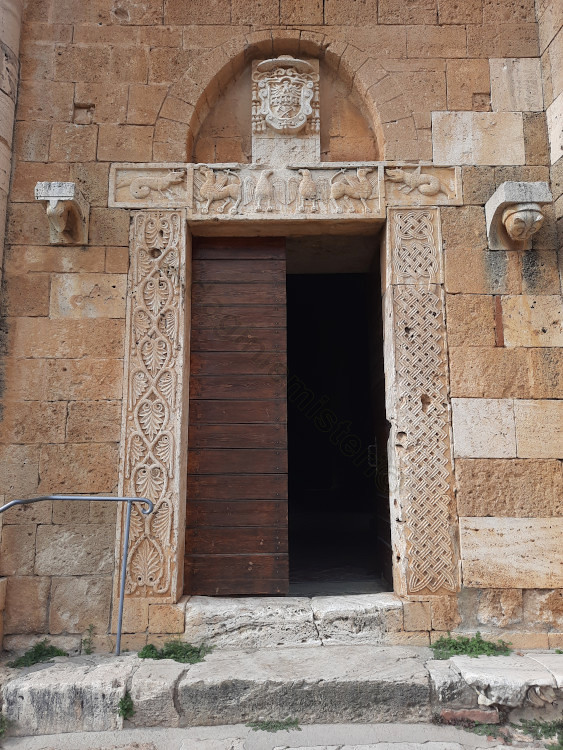
The facade
Walking along the south side of the church, the visitor is finally faced with the facade. The salient façade appears incomplete, perhaps due to the heavy financial commitment required by the 12th-century extension work, which the Benedictine monks could no longer cope with. From top to bottom there is a mullioned window and a monofora, while the lower part shows traces of a fallen portico. The entrance portal is in fact flanked by half-columns, with carved capitals, which formed probably its support.
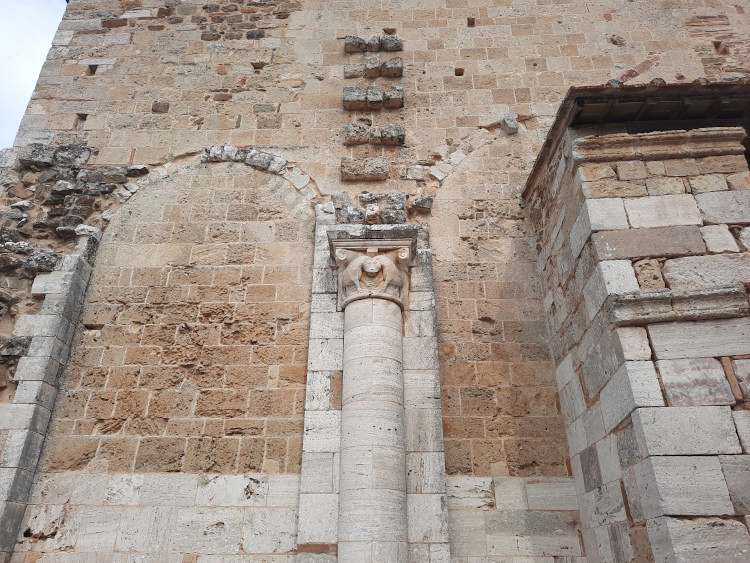
Most likely the entrance was rebuilt by the Wilhelmite monks after 1291, when the Abbey was supposedly already in a state of decay and structural collapses had affected the portico and part of the facade13. Reused material was employed for this purpose, as is evident from the carved ashlars on the top of the piers, on which a lion protome and the body of a fairy stand out. The architrave is decorated with elegant phytoform volutes, a reminder of the symbolism of the tree of life, the image of Christ. On the counterfacade side it bears an inscription in Latin characters, which reveals that a certain Azzone da Porcari was auctor praevius istius egregiae aulae, master builder of the church14.

The Abbey of Saint Antimo, reaching out to the light
Every stone, every innermost essence of the abbey of Saint Antimo required the pilgrim to make an inner path, to go towards the light. Not by chance, the Benedictine master builders had oriented the edifice to the east. The faithful, walking down the aisles to the apse, proceeded in the direction of the place from which the sun rises and, in a metaphorical sense, toward Christ, the light of the world who was born in the East.
“The true light, which enlightens everyone, was coming into the world”.
Gospel of John 1,9
This movement – to be understood in the physical sense, in relation to the sacrifices of pilgrimage, but especially of the soul – was necessary for man to escape from obscurity, from that darkness of death and sin that hid the meaning of existence. In Medieval theology, knowledge was possible only through an illumination from God; Augustine of Hippo, in the Confessions, had argued the impossibility of man finding the direction of his life on his own. Thus, in the abbey of Saint Antimo the faithful turned his gaze to the East and by light he knew salvation.
Samuele Corrente Naso
Map of places
Notes
- A. Canestrelli, L’abbazia di S. Antimo, monografia storico-artistica, Tipografia Lazzeri, Siena, 1910-1912. ↩︎
- Diploma dated March 12, 951 or 952 from King Berengar II and King Adalbert to Abbot Betto and now preserved in the State Archives of Siena, transcript in E. Duemmler, Italienische Koenigsurkunden des zehnten Jahrhunderts, in Forschungen zur deutschen Geschichte, Verlag der Dieterichschen Buchhandlung, Goettingen, 1875. ↩︎
- G. Tigler, Toscana romanica, Milano 2006. The original document is kept at the State Archives of Siena. ↩︎
- Ibidem nota 1. ↩︎
- M. Salmi, Chiese romaniche della Toscana, Electa, Milano, 1961. ↩︎
- H. Delehaye, Commentarius perpetuus in Martyrologium Hieronynianum ad recensionem H. Quentin, in Acta Sanctorum XXIV Novembre 11, II, Bruxelles, 1931. ↩︎
- Passio sancti Anthimi presbiteri et martiris, mense Maii die XI , et aliorum sanctorum, Bibliotheca hagiographica latina (BHL 561). ↩︎
- La “Passio” di san Donato vescovo di Arezzo. Edizione critica, translation and commentary by Pierluigi Licciardello, Firenze, 2018. ↩︎
- W. Kurze, Zur Geschichte der toskanischen Reichsabtei S. Antimo im Starciatal, in Gerd Tellenbach zum 65. Geburstag dargebracht von Freunden und Schülern, Freiburg, Basel, Wien, 1968. Si riportano le parole dell’iscrizione: Bernardus Comes filius Bernardi Comitis dedit et confirmavit Ildibrando filio Rustici totum quod habebat, aut alii per illum habebant in toto Regno Italico, […] Ildebrandus […] sicut recepit a supradicto Bernardo omnia supradicta in hoc monasterio S. Antimi universa jure
proprietatis germanus ejus Fortis et arid […] in perpetuum. ↩︎ - By Sailko, CC BY-SA 3.0, immagine. ↩︎
- Bull of Nicholas IV dated August 22, 1291. ↩︎
- Ibid footnote 1. ↩︎
- E. Repetti, Dizionario geografico fisico storico della Toscana, ed. Emanuele Repetti, Firenze, 1833 ↩︎
- A. Peroni, G. Tucci, Nuove ricerche su Sant’Antimo, Alinea editrice, 2008.The full inscription reads: Vir bonus in Christo magnis virtutibus Azzo cenobii monachus pater postique decanus istius egregiæ fuit auctor previus aulae atque libens operis portavit pondera tanti progenie tuscus Pocorum sanguine cretus pro quo christicole cuncti Deum rogitate det sibi perpetue cum sanctis gudia vite martir et eximus sit custos Antimus eius. ↩︎

